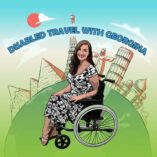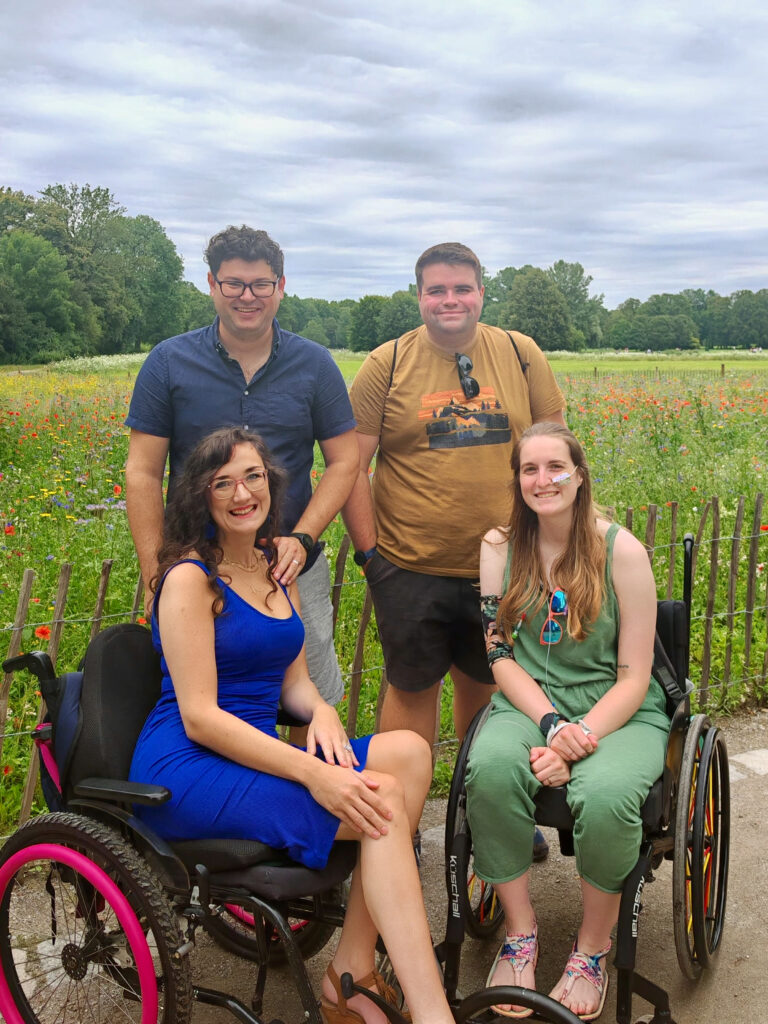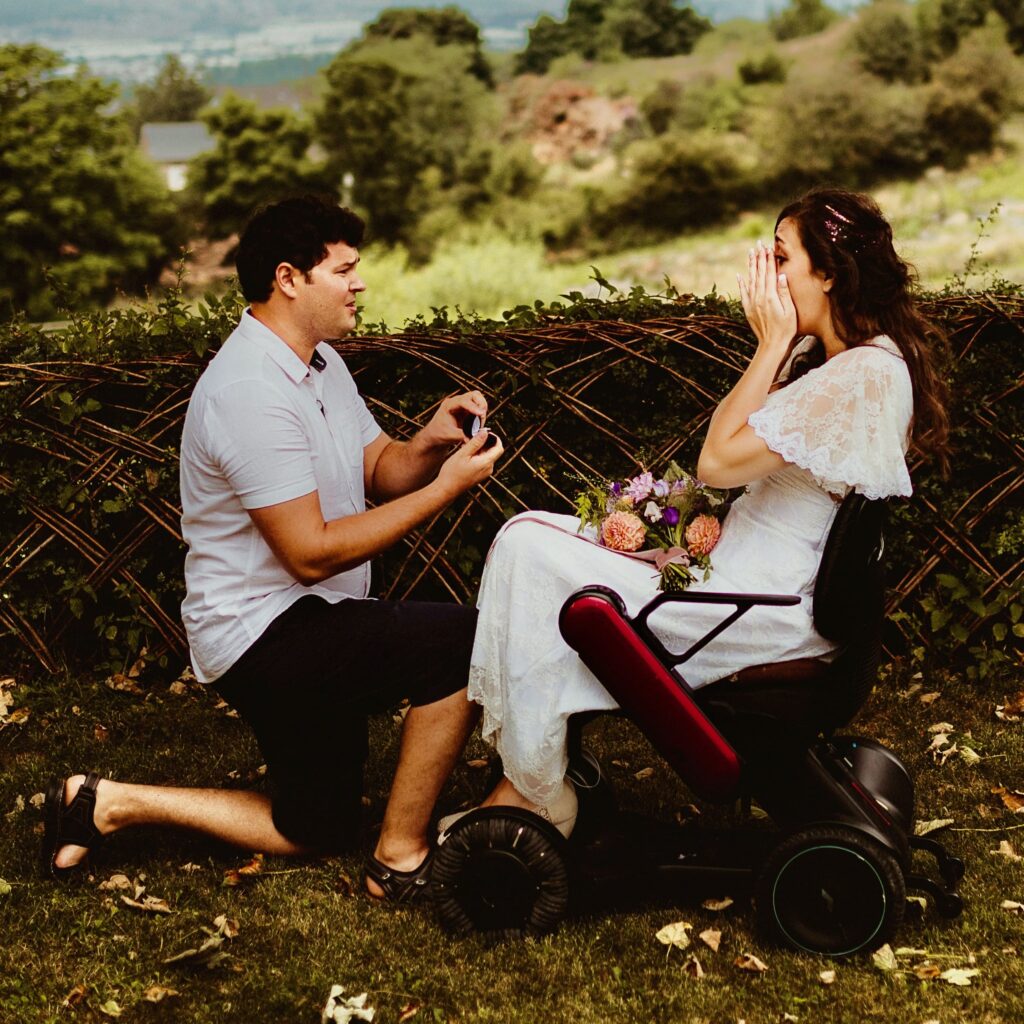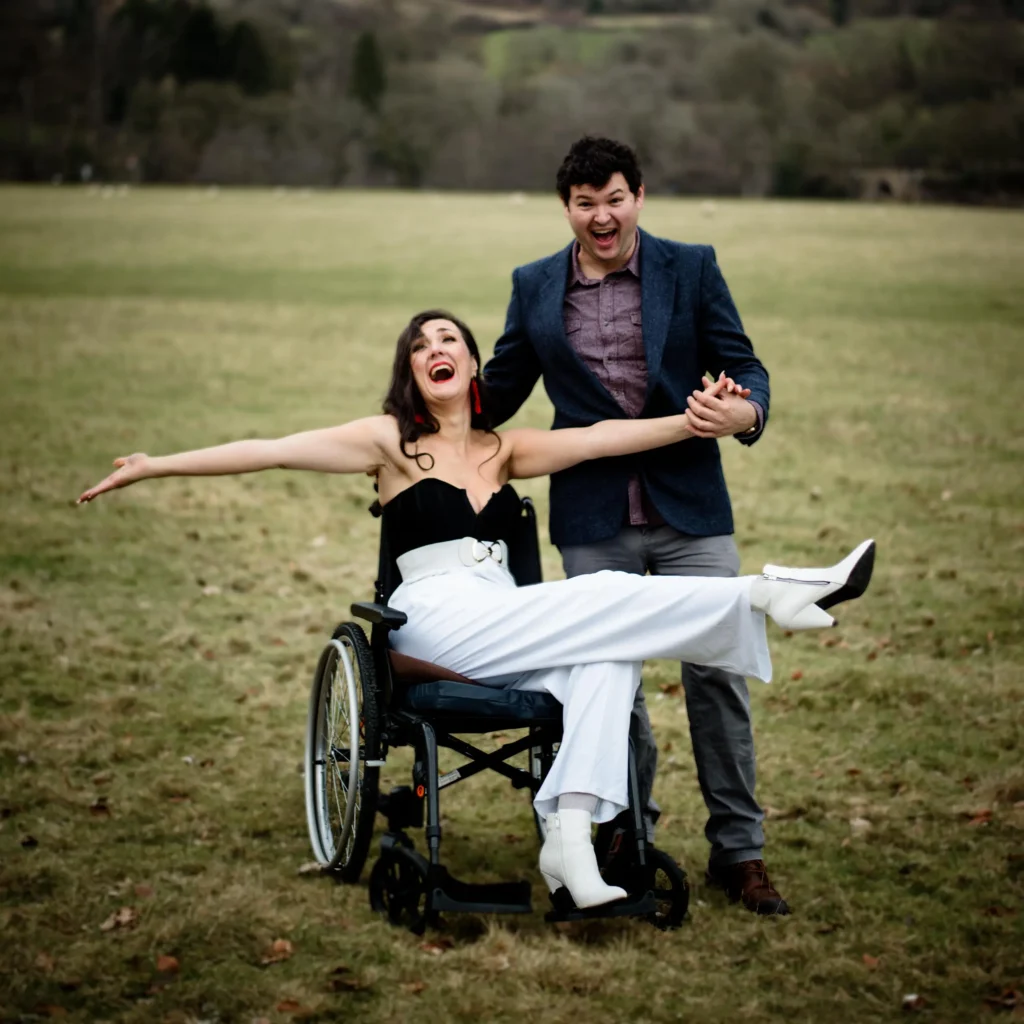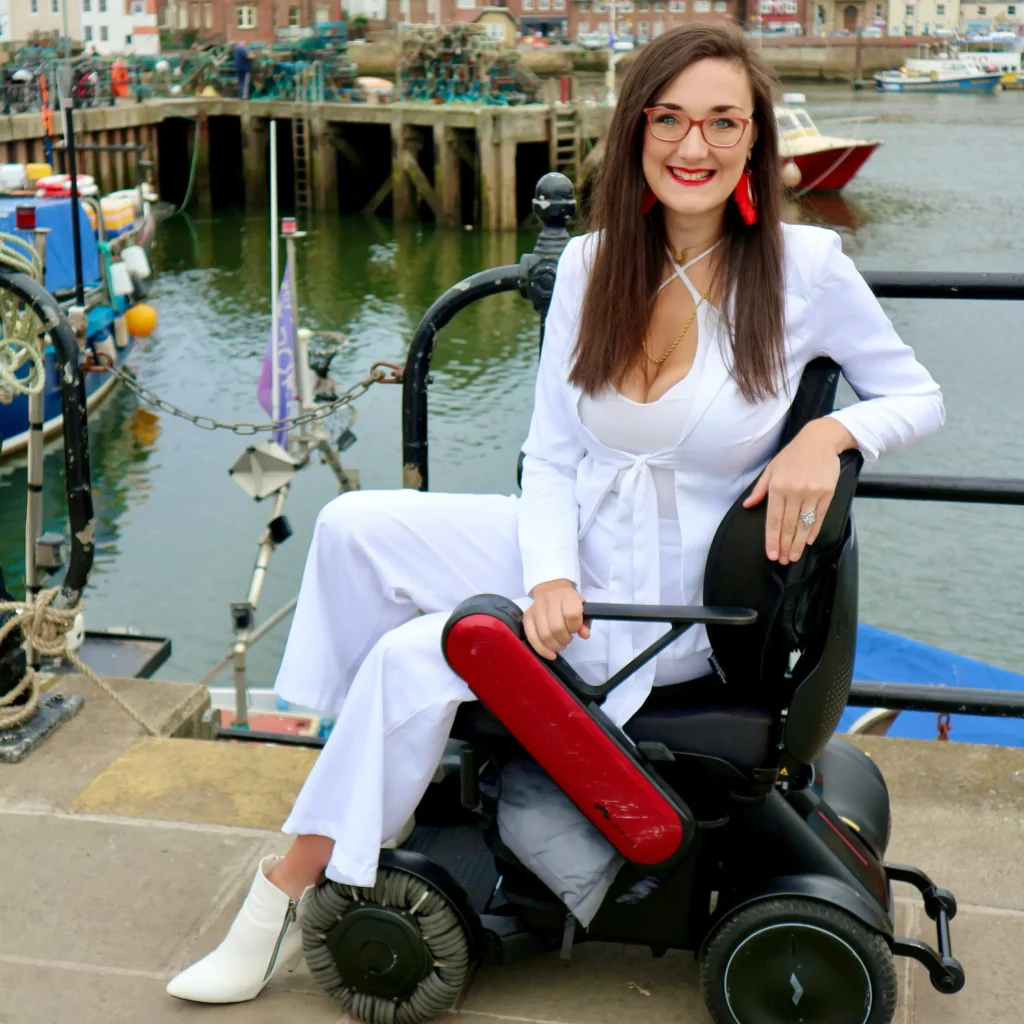Munich was a city that had always been on my list of travel aspirations so I was thrilled when Wombat’s City Hostel, Werksviertel reached out to host us. As always, all opinions and thoughts below are authentic. This article was written in late July of 2024 so prices and access details at the attractions may change across the years.
Munich is so much more than beer and pretzels (although, both the food and the drink available were sublime!). The social life within the city of Munich was bustling and vibrant with such a variety of different cuisines on offer alongside traditional German food and steins of beer. Munich really did have something for everyone, including a famous “Old Town” with a central square called Marienplatz. From here, you can see the famous Glockenspiel which performs a musical routine 2-3 times a day depending on the season. This is situated amidst the gorgeous architecture of the new and old town halls, one of which actually has an elevator up to a panoramic view of Munich. More details on all of these below and in “Part Two” of this blogging series.
With over 80 museums, you can settle your intellectual curiosity surrounding so many subjects or pique your artistic spirit. Within easy reach of the city are Neuschwanstein Castle which inspired Disney’s Sleeping Beauty castle design and also Salzburg in Austria. We unfortunately couldn’t visit these two in our short stay but instead we have detailed access information on so many inner city museums, historic beer taverns and also on the historically important site of Dachau Concentration Camp Memorial Site.
Below is my husband Richard in front of the Rathaus-Glockenspiel which has moving characters and sounds that play 2-3 times a day, depending on the season. He is dressed in our interpretation of traditional German clothing for the Kocherlball which is a sunrise party with traditional dress and dancing at the Chinese Tower of the English Garden at the centre of Munich. More on this fantastic seasonal event later.
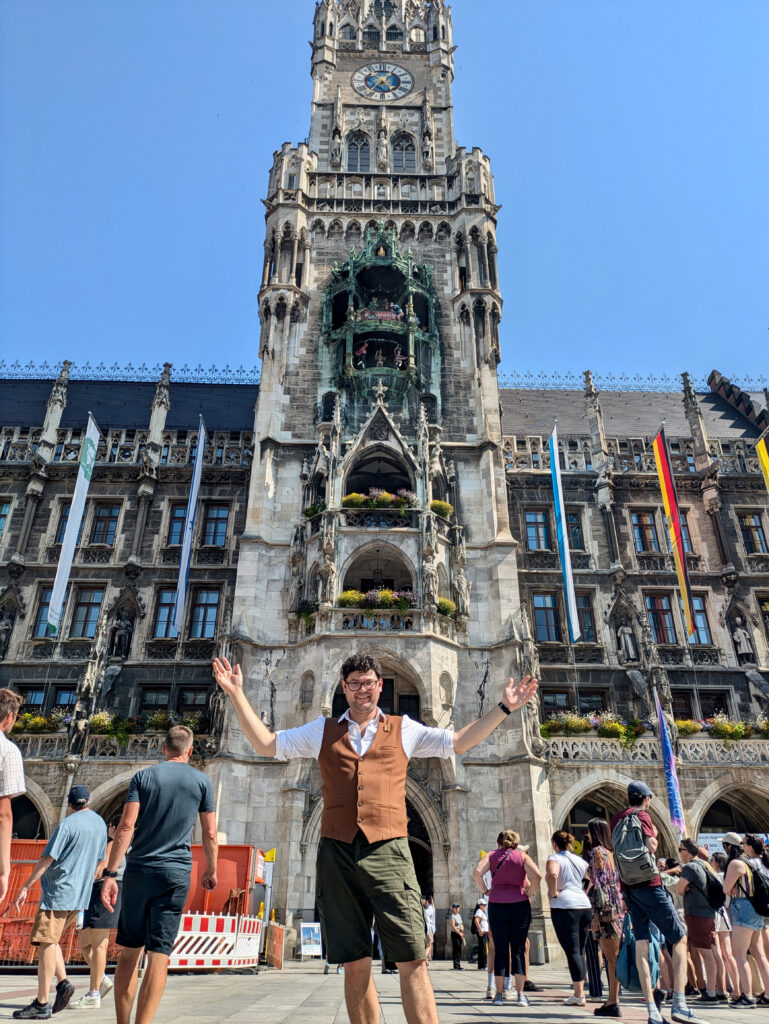
Richard and I travelled with some friends (Mary & Tim) to explore the city and see all of the sights. Mary has similar health-conditions to me so uses a wheelchair to mobilise. Using Wombat’s Hostel as a base was perfect as it was within easy reach of the public transport hub to take us to explore the city centre and the many attractions and historical sites surrounding Munich. I loved that we could easily pop back for a rest (essential for two chronically ill wheelchair users!). The hostel’s location was absolutely ideal as it was within Werksviertel which is a very trendy, modern area of the city with many restaurants, “grab & go” street food options, nightclubs and bars. It is also right by the Umadum Ferris Wheel which you can actually see spinning from some of the Wombat’s Hostel windows in their Munich Werksviertel site. This ferris wheel is 80 metres high and is fully accessible for wheelchair users. We didn’t ride this but did ask at the kiosk and they have reduced rates (€10 for the disabled ticket) when you present “proof” of your condition, including a Blue Badge (for UK disabled parking) or European disability card. Many attractions in Munich also give a free companion/ carer ticket when you show “proof” of your disability.
We visited the Werksviertel Wombat’s site but there is also a Wombat’s hostel in Hauptbahnhof within Munich city centre. They also have locations in London, Vienna and Budapest. Please see here for my previous review on Wombat’s Vienna if you are looking for accessible accommodation or non-adapted rooms for groups/couples within Vienna. During our Munich trip, we met so many different people who were travelling in groups, as solo travellers or as couples. There was a lovely dynamic as there was a mix of ages and different group dynamics. Despite there occasionally being a language barrier (I do try but my German linguistic skills aren’t the best!), every single person we spoke to at Wombat’s Munich Werksviertel was so lovely. People stopped to chat, made new friends or helped each other out with queries as to the best places to visit or dine at.

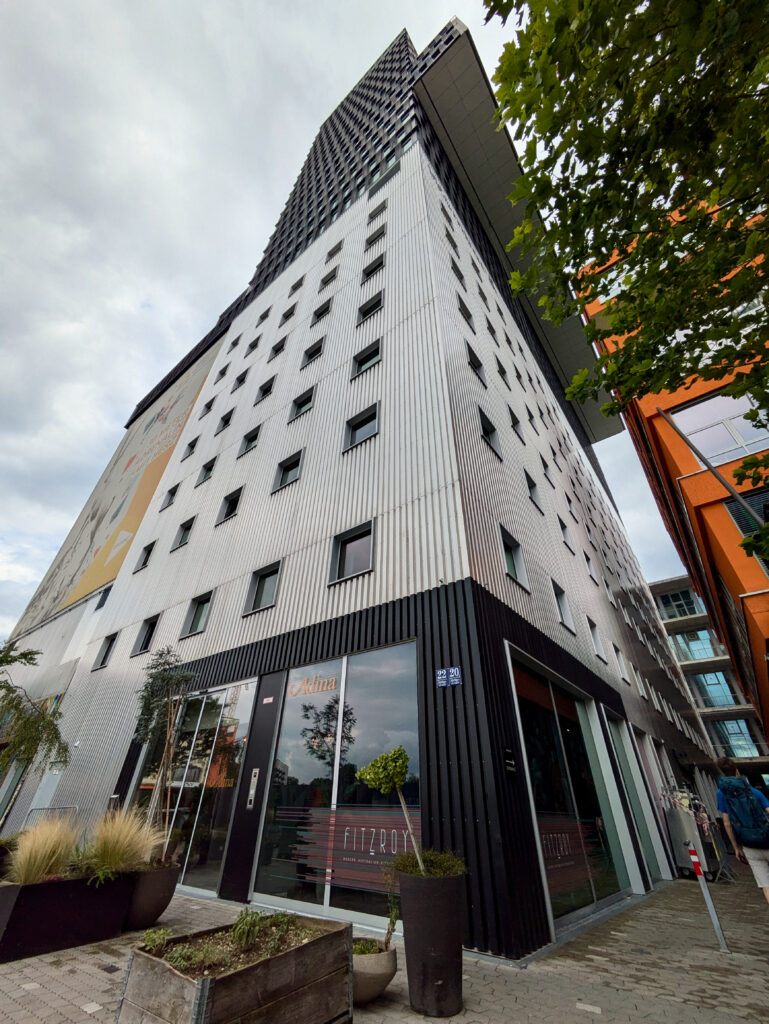
On the Wombat’s Hostel website, you can see that there are various different room sizes to accommodate the huge variety of travellers. You can stay in private double rooms, private twin rooms and 4, 6 and 8 bed dorm bunkbed rooms which can be private or shared. Private room hire means that the room is yours in entirety and is used for your party of guests only. Private hostel rooms will not be shared with other travellers who check in to Wombat’s but shared rooms can be, allowing you to meet new friends. You can also choose female only rooms for 4 or 6 travellers if you are willing to mingle and meet other guests but would have a preference for this same-sex dynamic. We have toured and photographed the other room sizes so will add more details within the next article I write about Wombat’s City Hostel, Werksviertel.
Our room was a private 6 bed dorm bunk room; this is the disabled accessible accommodation size on their site. Currently, you can only book this specific room through calling or emailing Wombat’s directly. You can find the contact details for all of the hostels on this page so you can book within the Werksviertel Munich site we stayed at, or speak to other locations. It is always best to book through the hostel directly and also to phone/ email them if you have specific access requests.
This is a view from the bunk bed I shared with my husband – you can see the other four beds opposite us and across the room.
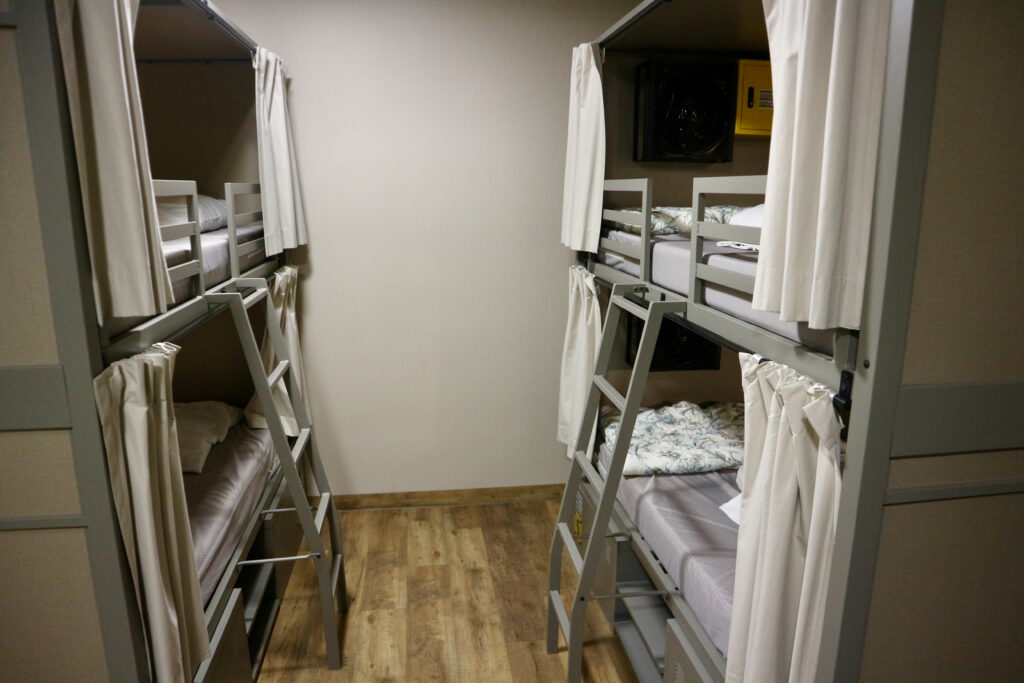
To get into the accessible 6 person room, there is a bank of two lifts which always arrived promptly. You need to go up one floor to Reception to check in from the level-access entrance. The staff here were really helpful with any query I had whilst travelling and the check in process was very quick. Remember to bring photographic ID (passports/ driving licenses are perfect) but it was really quick to go through this process. There is a communal workspace directly beside Reception, lit up by loads of lightbulbs in a very modern, aesthetic design. This was always busy but everyone was respectful of those in meetings/ trying to meet deadlines.
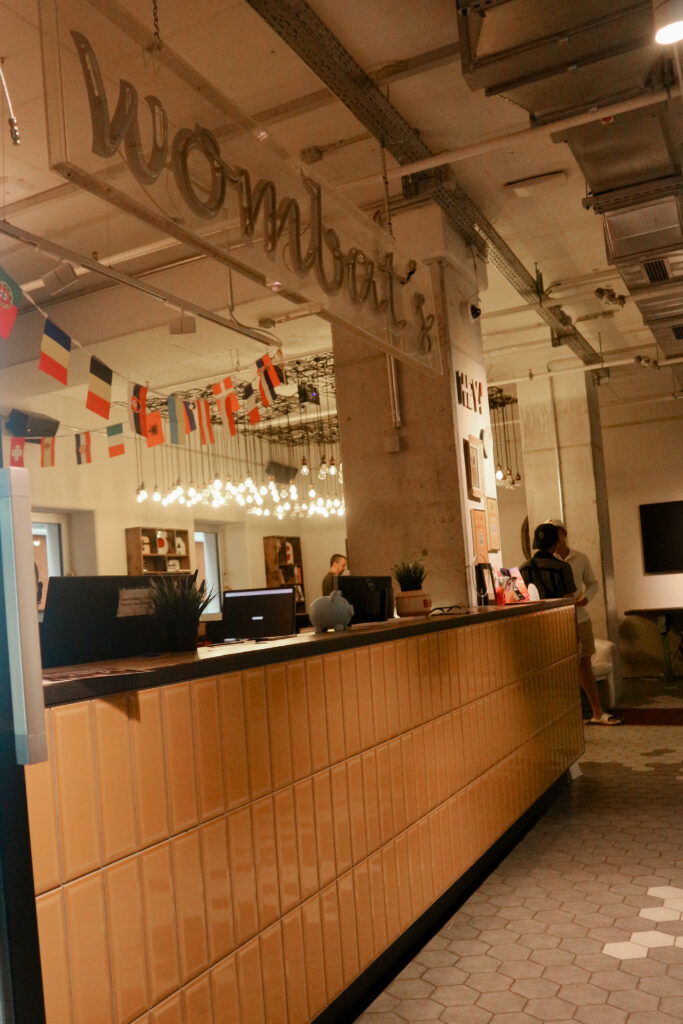
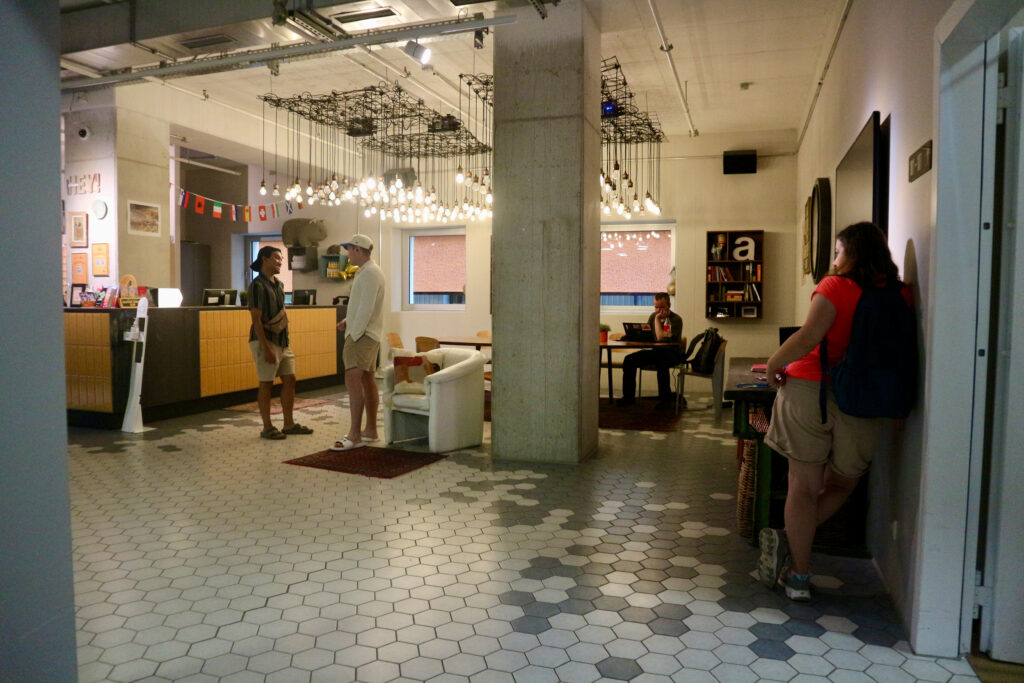
If you would prefer a cosy space to just chat to others in your party, or to meet friends, then there is also a lounging space nearby. This was very popular and I saw groups of people making use of the communal guitar and board games whilst resting from the unseasonal heat!
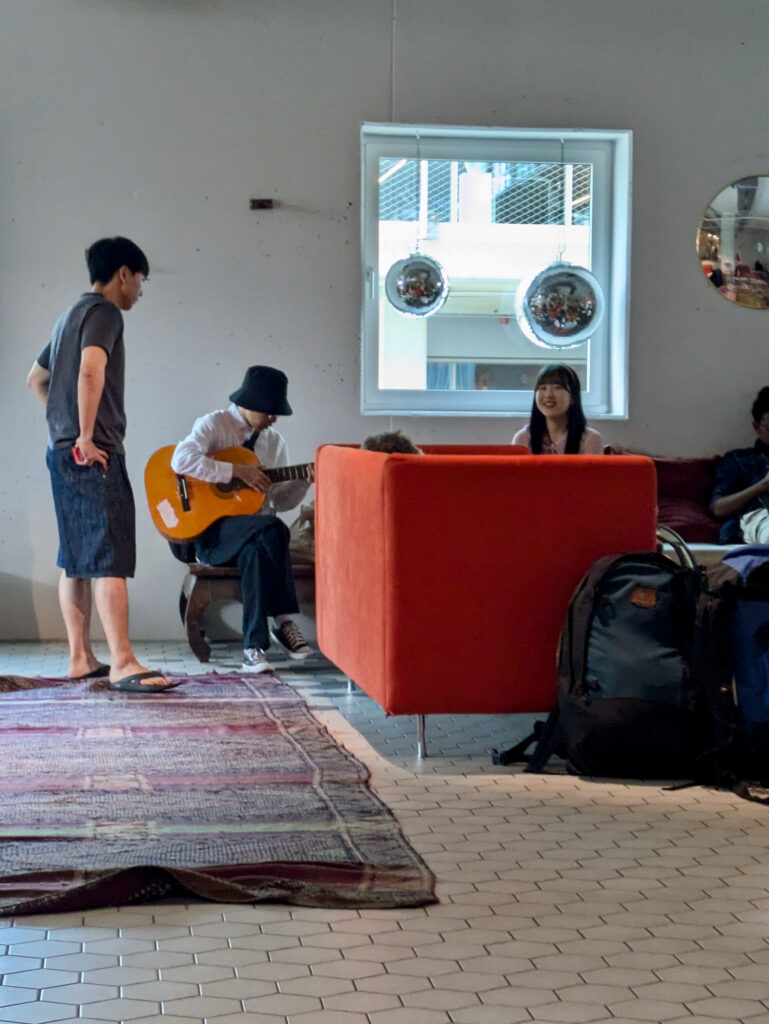
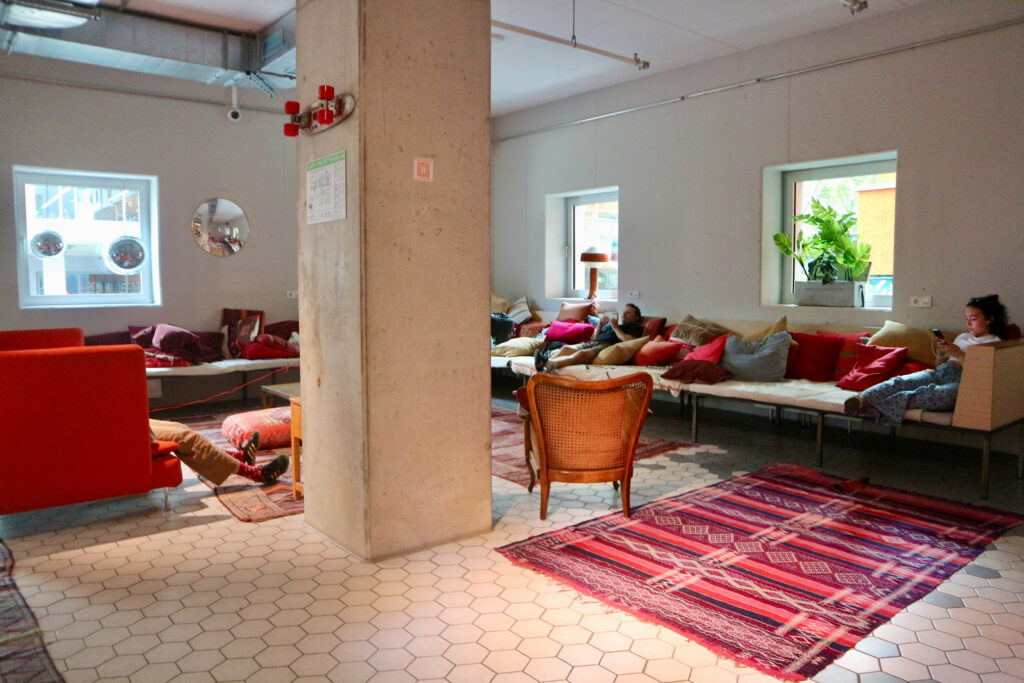
After checking in, we entered the lifts again and went up another floor towards Room 213, the wheelchair friendly accommodation in Munich within this Werksviertel site. Each lift was plentifully big enough for two manual wheelchair users to enter (Mary & Georgina) alongside their two abled husbands who stood alongside them. The lift buttons were within easy reach of our lowered heights and were clearly labelled so you could tell which floor the “main attractions” were on such as reception, the WomBAR and Wombat’s CAFÉ. More on these areas later of course and more detail in the next blog post.
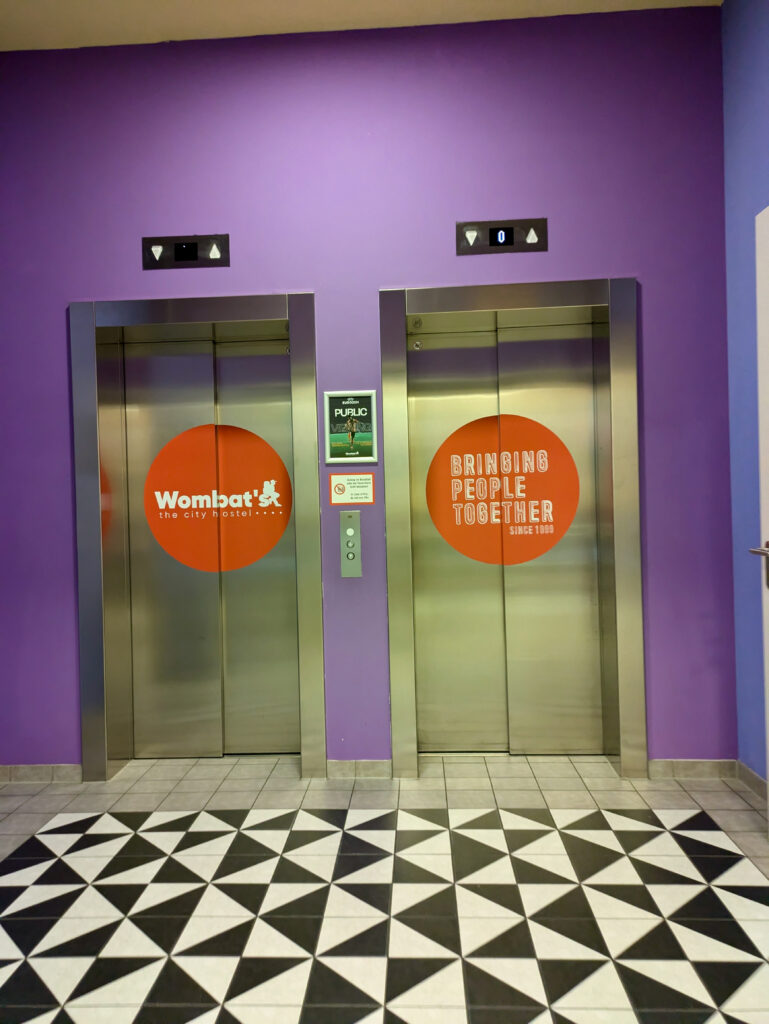
The corridors were wide and smooth and neither Mary or I had a problem with width of any doors. The automatic door as you enter the hostel from the street was absolutely ideal as many travellers will be overladen with suitcases/ backpacks whilst travelling so it was a good design idea on the main entrance. Again, we had no problem entering the room and our bedroom door even had an automatic close button to fully close it behind you.
I absolutely loved staying in bunk beds; it gave a youthful, sleepover vibe within the room and also gave a higher amount of privacy with bed curtains which could be closed, particularly if you are sharing with others you might have just met. Even if you have reserved the whole room privately with a group of people you are travelling with, the curtains allow you to block out any light within the room.

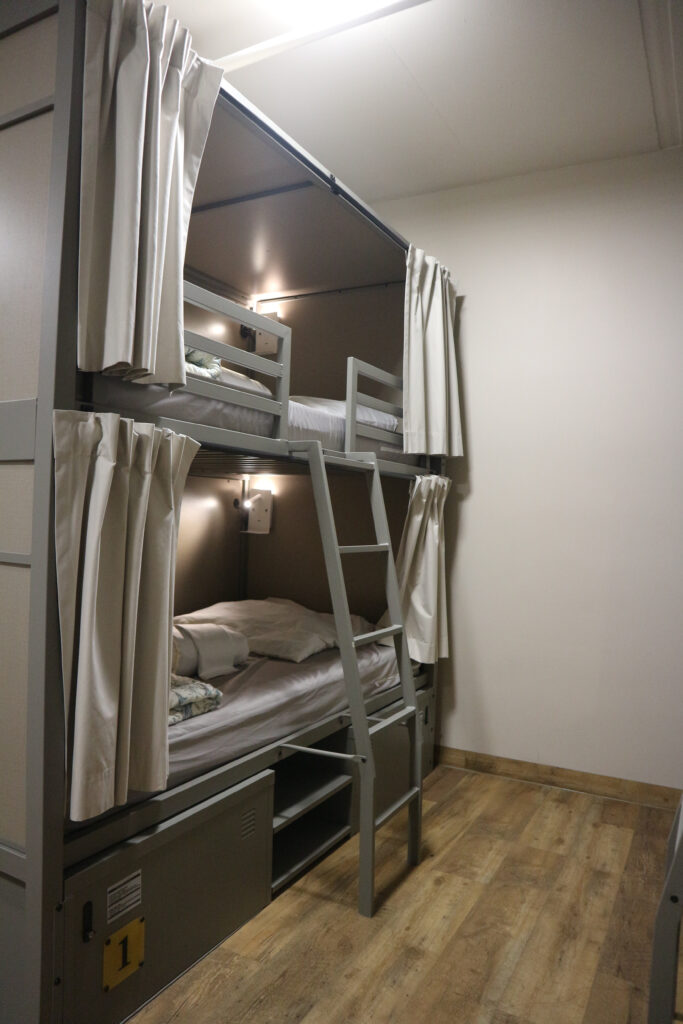
Inside your little bunk bed space, there was a small shelf for placing your phone or similarly sized items. Above this shelf there is a small bedside lamp and a USB charging port. This was really handy for those who are travelling between different countries as you would always have the ability to charge your devices without an adapter plug (these were available to borrow at reception though). At the foot of the bed was a lockable small safe which could keep any important items safe with a four digit pin code. You could charge another device with a EU plug socket within this safe. Next to this was a small fan which blew air at your bed space. This was particularly useful as it was very warm in the mid-summer month we visited in and each guest could choose the temperature and airflow in their space according to their preferences.
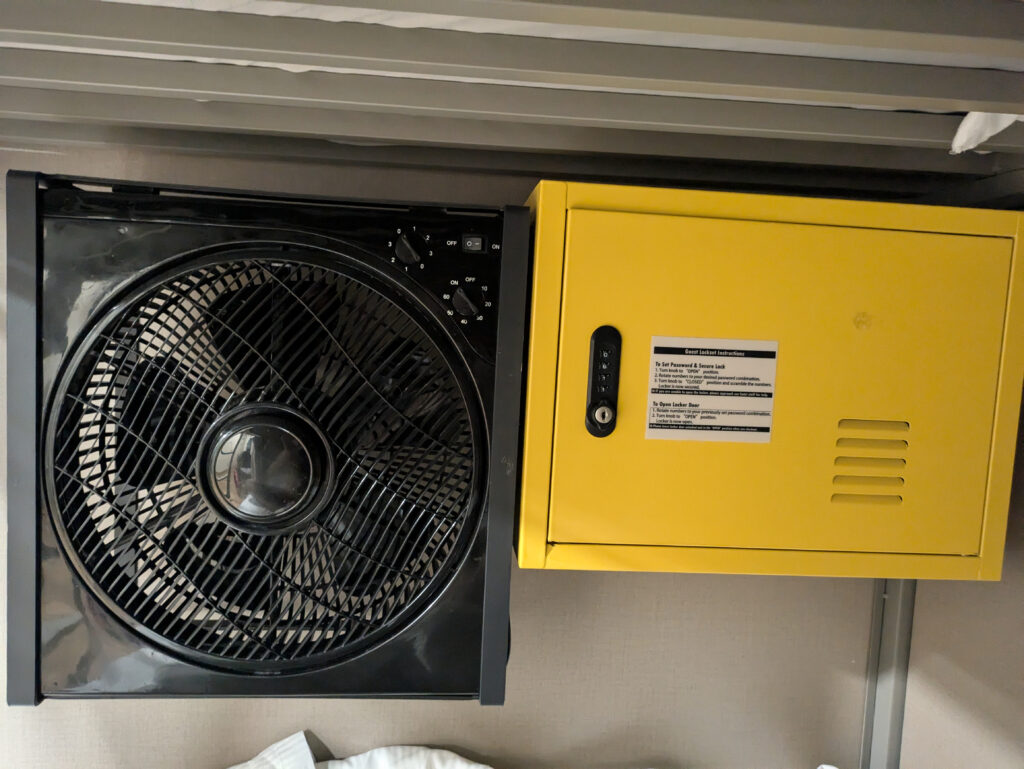

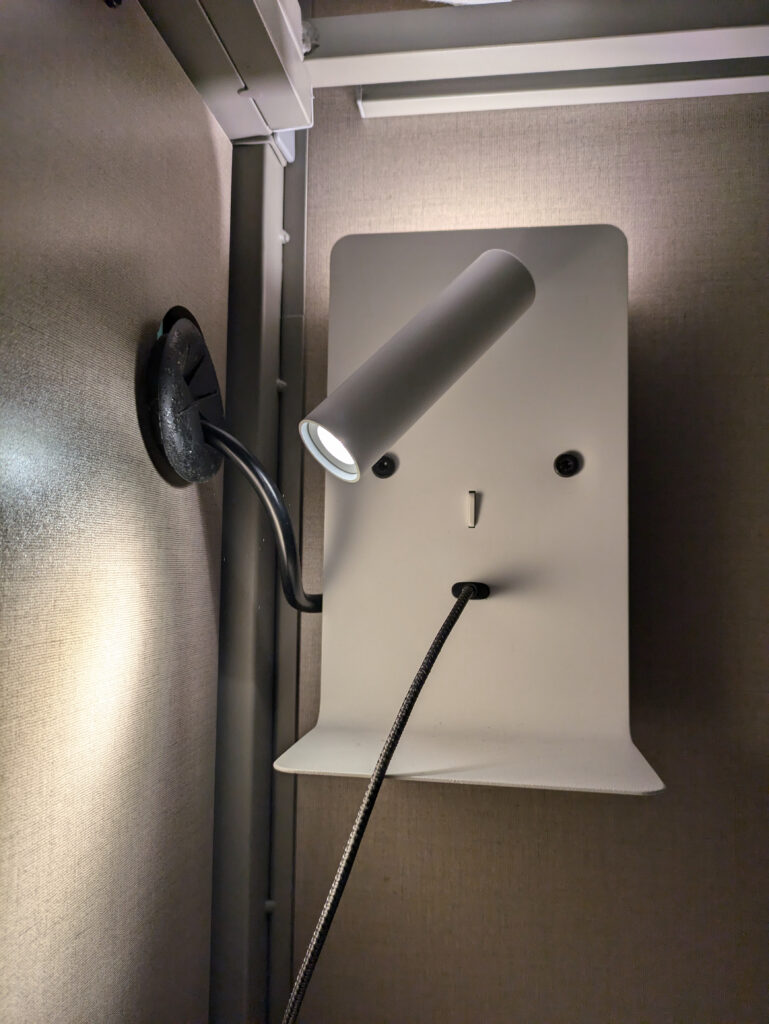
Since some of our group have a medical condition which is triggered by too much heat, Wombat’s Hostel kindly also lent us a larger fan to use in the communal room space. We phoned ahead and asked for this since it was a medical necessity for us. They also kindly provided a kettle on our request since we both use boiled sterile water in our medical regimes.
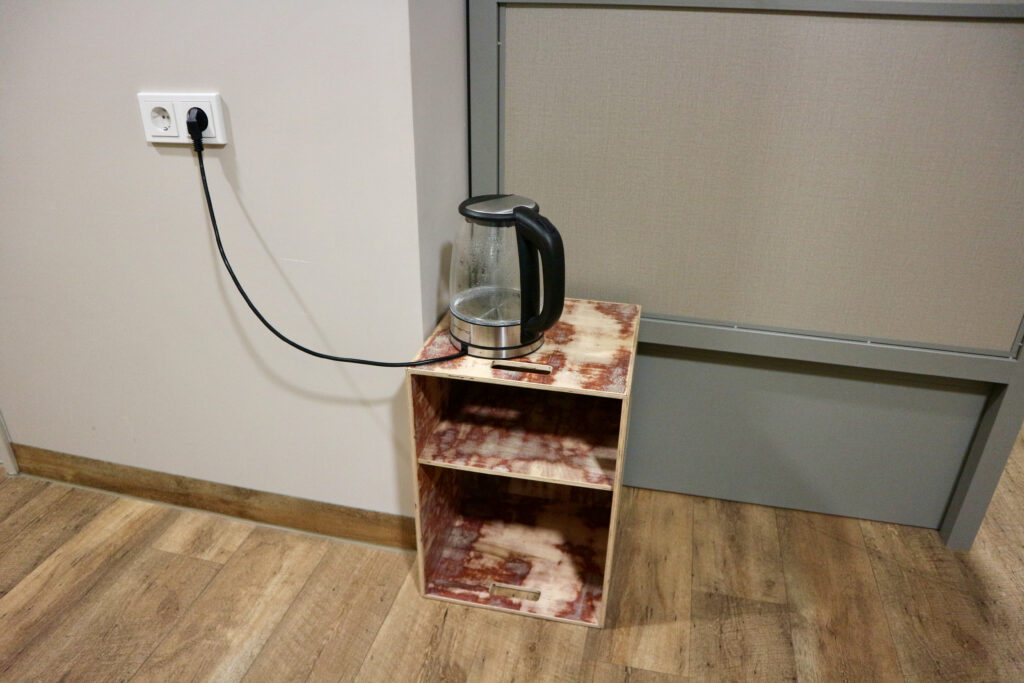
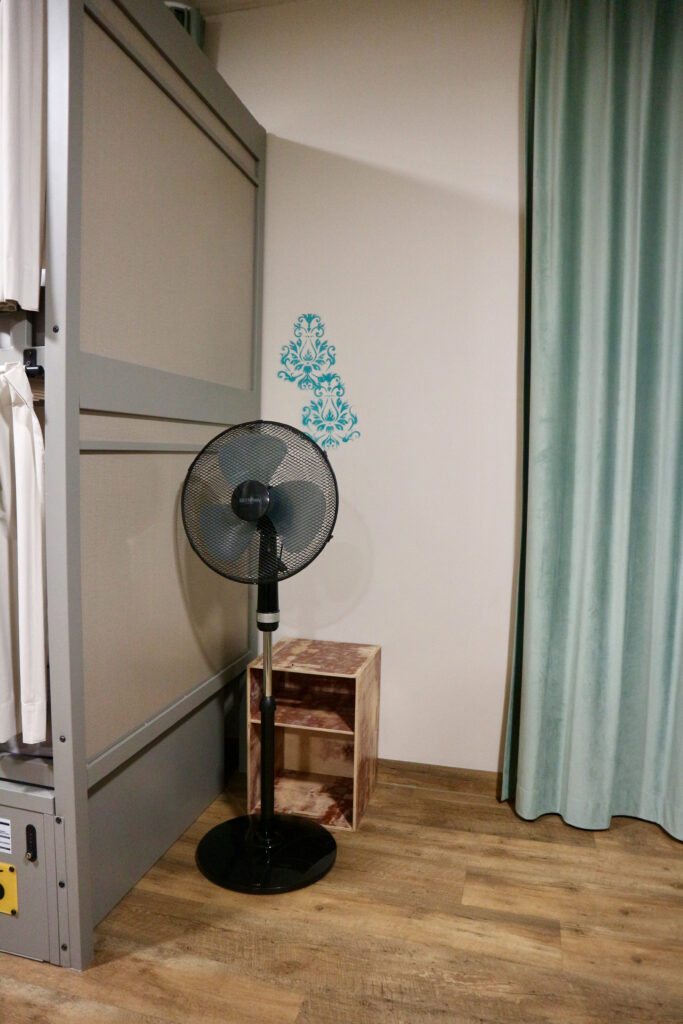
Underneath the bed, at ground level, was a shelving rack which we used to store our shoes during our stay. There were also two large lockable storage areas which were clearly labelled to be allocated to each bunk. These were very large since they fitted our biggest suitcase which goes in the aeroplane hold. You could also lock these with a four pin plug so your belongings were safe, secure and out of the way. It was really handy to keep your belongings locked away safely but also these helped keep the room tidy and easily cleanable for the onsite cleaning team who visited daily unless you placed a ‘Do Not Disturb’ sign on your door handle.
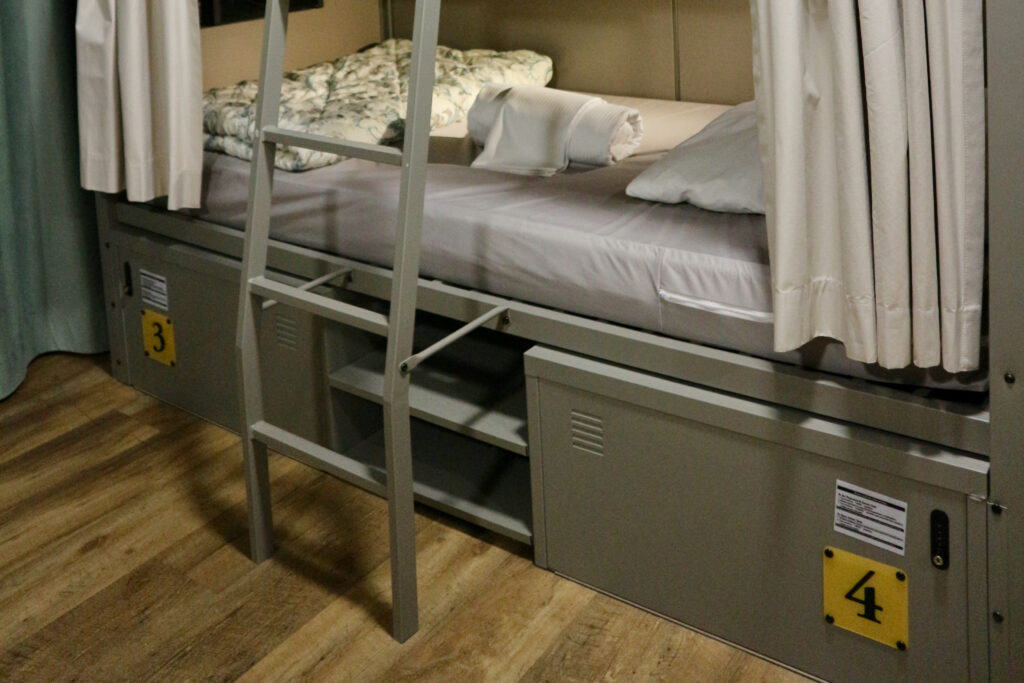
If you had any other items you’d like on-hand at all times rather than being locked away then there was also a large shelving area within the alcove. You could also hang your coats, hats or towels on the communal hooks beside the shelf.

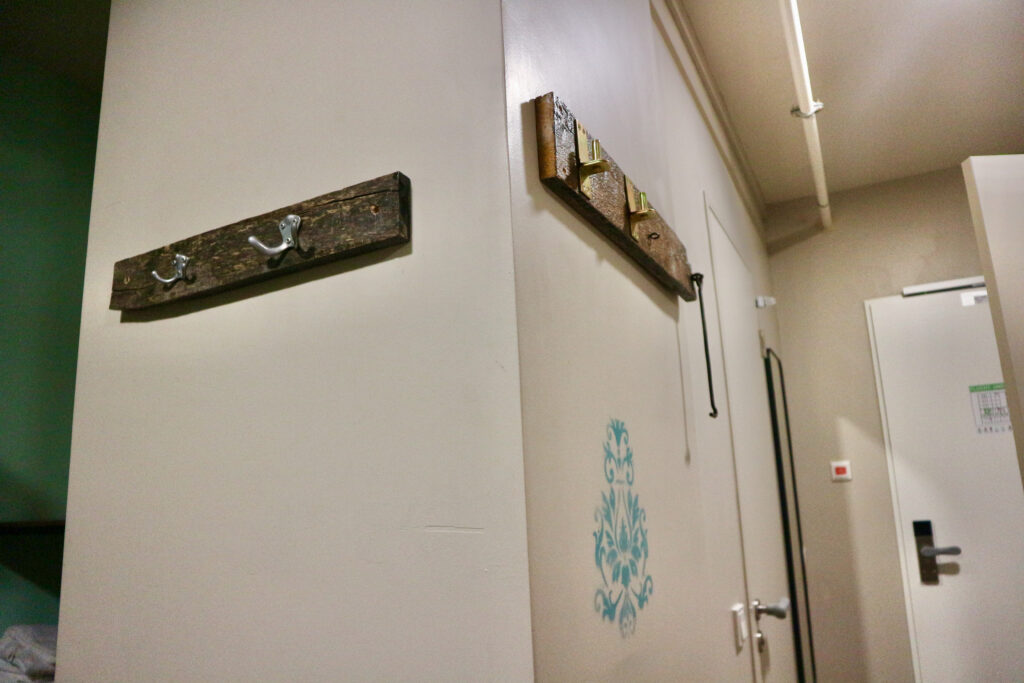
We were very pleasantly surprised to find two bathrooms within the bedroom; this would be very helpful if you were sharing in a group of six people so that everyone can easily get around to using the toilet/ shower facilities. Beyond that, it was really exciting to see an adapted bathroom alongside a standard bathroom since you could use both bathrooms if you were travelling in a group of mixed abilities.
Within the non-adapted bathroom, there was a toilet with a toiletry shelf above it for easy storage of bathroom items. A sanitary bin and toilet brush were within easy reach of a seated position on the toilet. Opposite is a sink, shower stool and mirror within one to two paces from the toilet. If you were ambulatory and could walk a little, this bathroom was compact enough for you to easily get from one side to the other. However, it is unlikely you would be able to fit your mobility aid within the room.
Within this standard bathroom area, there was also a large shower cubicle with a small step to enter. The shower water got really nice and warm in both shower areas and we had no problem during our stay with the hot water at Wombat’s City Hostel, Werksviertel running low. You could adjust the temperature and water flow pressure also if you have a strong preference there. Both bathrooms and all areas of the room were kept to a really high standard of cleanliness since the friendly cleaners came in once a day.
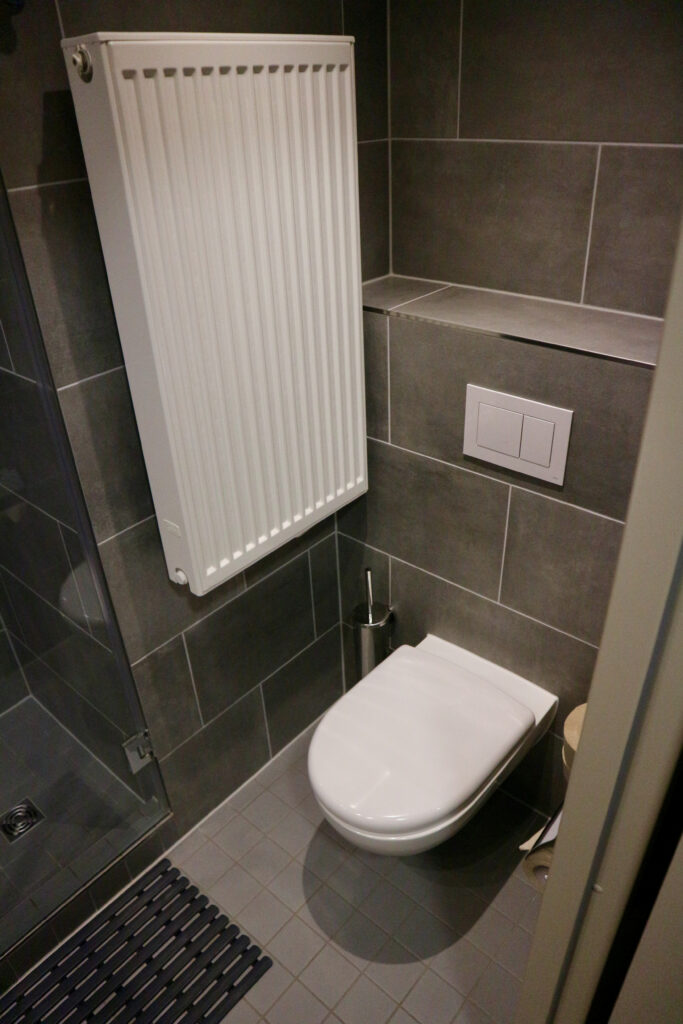

Opposite to the standard bathroom, there is a much larger bathroom where I had no problems getting my manual wheelchair in and around. All handles in the room had ergonomic rubber grips to help those with dexterity concerns and also to keep the “touch zones” clean easier. The doorway was wide and the area was a wet room so was tiled throughout (a good surface for rolling over with wheels). The toilet had grab rails on both sides that could be folded up against the wall or lifted down. There was an emergency red pull cord hanging all the way to the floor beside the toilet as well as an emergency button on the collapsible grab rail.
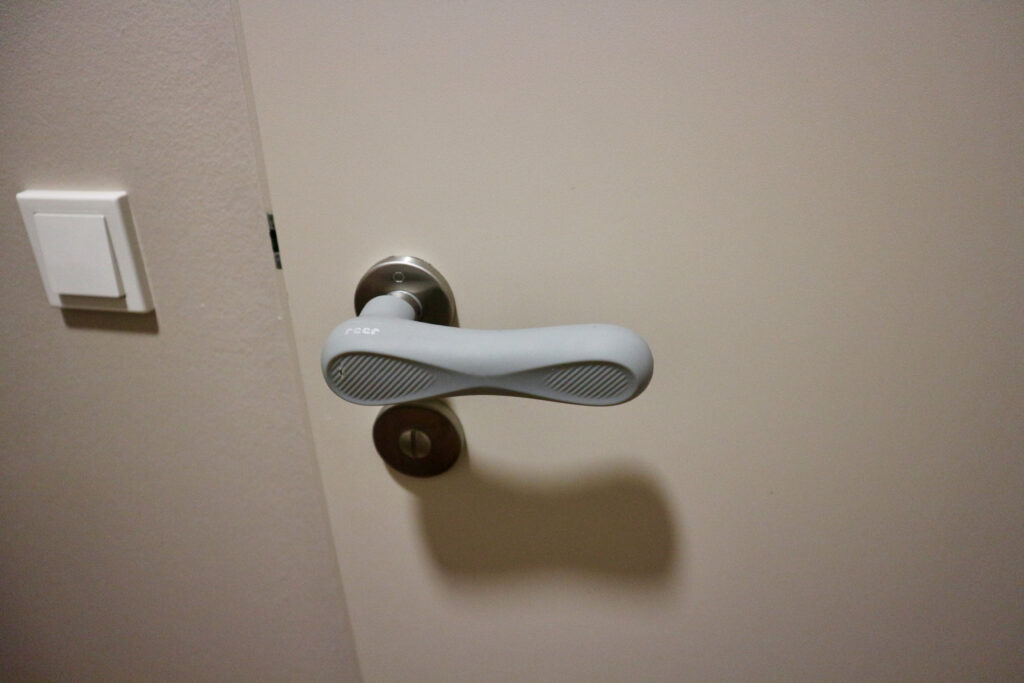
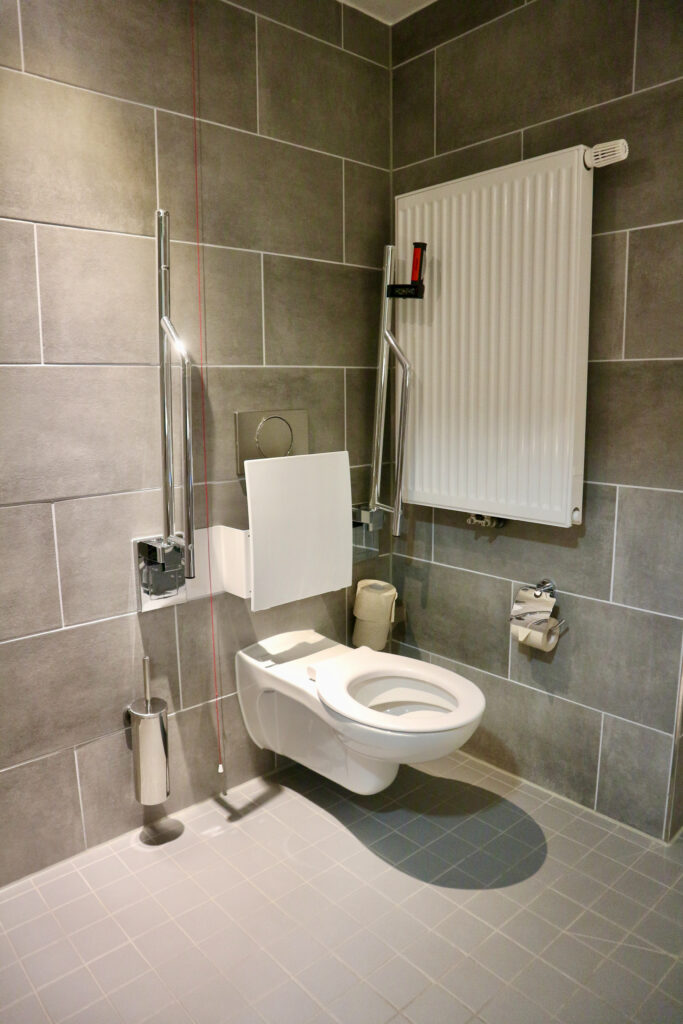
The sink is lowered to fit around a seated height and I could easily see out of the mirror above it. We moved the bathroom bin to easy reach of the toilet but that was no problem at all to lift and move around easily. The cleaning staff emptied all bins daily and kept them in the positions that we had moved them to for easier access.

The shower area was perfect for my access needs; there was a large shower seat with a chair back and supportive arm rests to help with transfers. The shower head could be removed from the mount or could be adjusted to a seating or standing height. Mary and I are both wheelchair users and we found this bathroom very easy to use and wheel around in. I would have loved to see a squeegee mop left in these wet rooms so we didn’t have wet wheel tracks through the bathroom and first part of the hallway. We sorted this as much as possible with towels though so we didn’t plague the cleaners with wet tyre tracks. You can change your wet towels daily at reception.
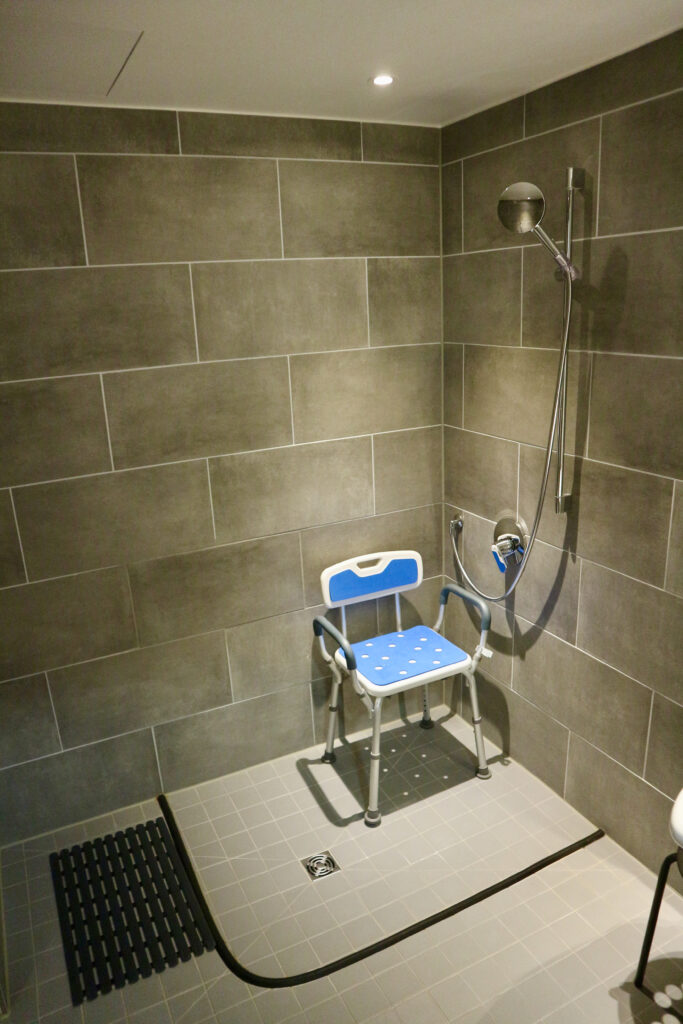
I personally found the bed very comfy throughout my stay. The communal area in the dorm room was fantastic as it gave us an area where we could really relax and play card games in our pyjamas!
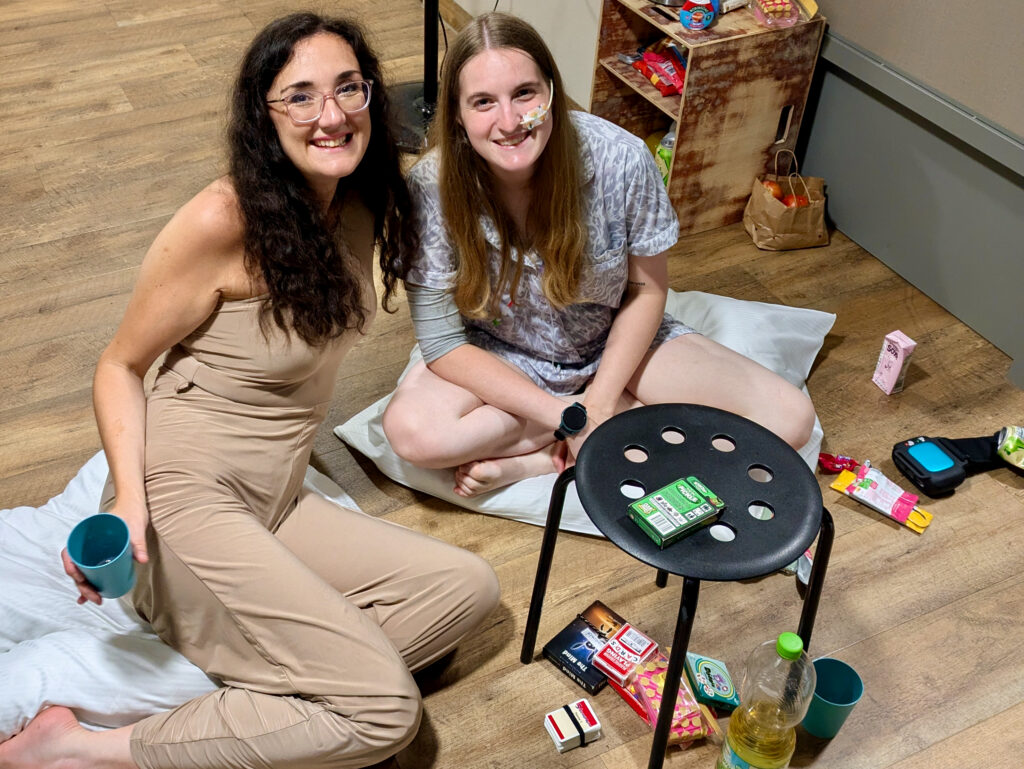
We also played cards (not in PJs though!) on the balcony terrace also on the floor below. It was a really nice area to chat in our little group of four but also to meet our fellow travellers and hear there experiences. This comfy outdoor area is actually in-view of a really tall climbing wall. Mary is a paraclimber so goes rock climbing regularly when her health allows. Therefore, this made really fun conversation amongst ourselves and other guests.
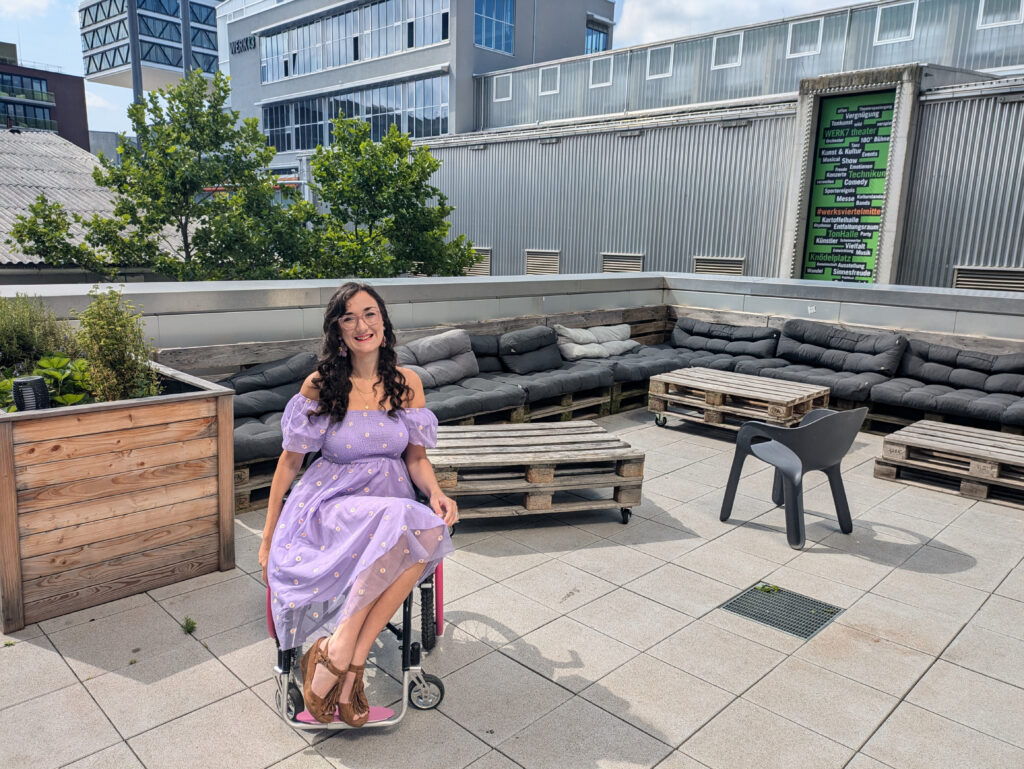
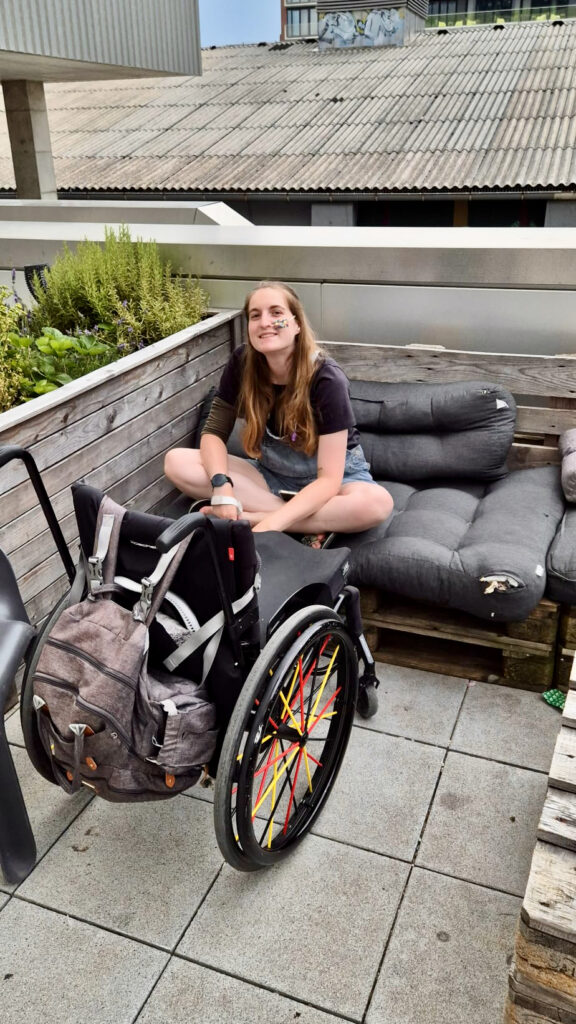
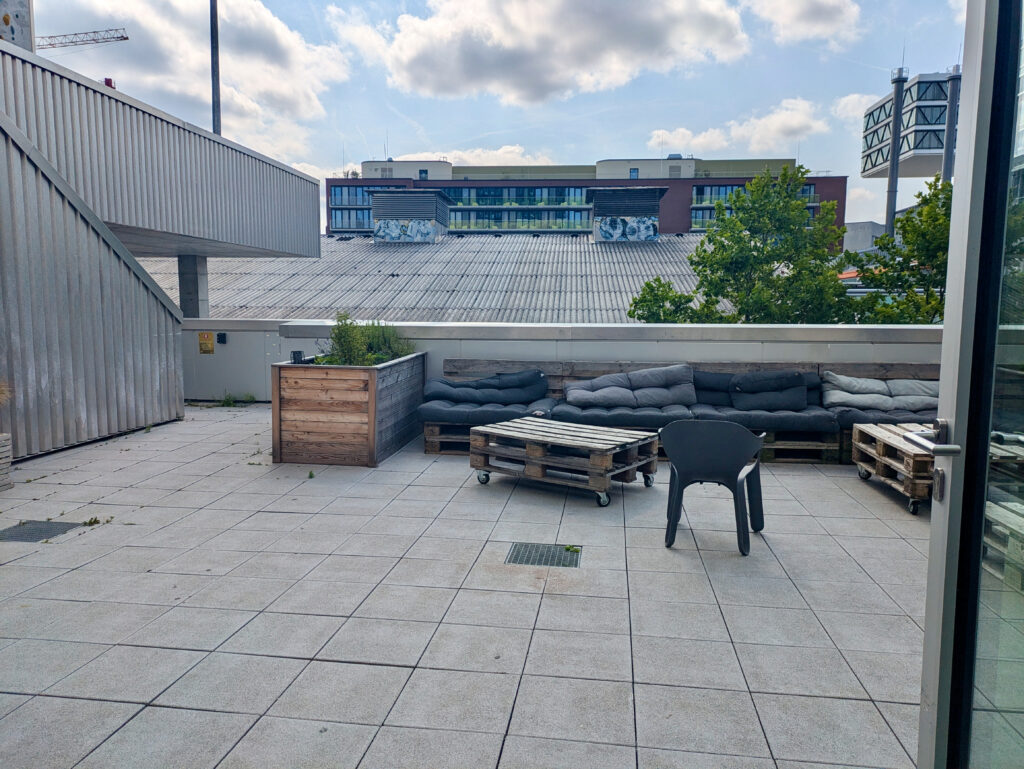
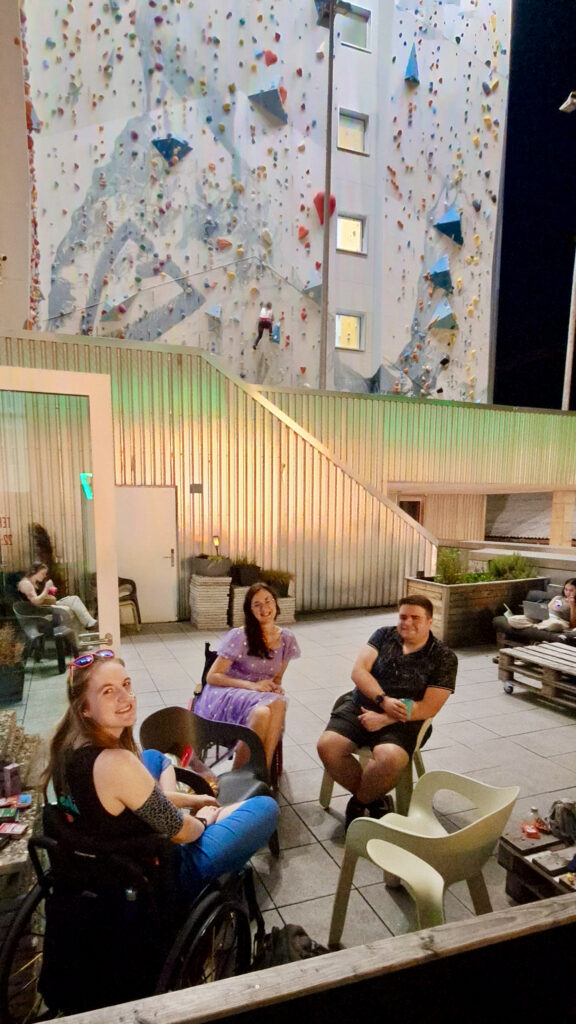
To get to this area you take the lift down to the first floor where reception is based. Past the reception desk and the really cool lit-up workspace area is a chill out zone. This was always pretty popular with people lounging, waiting for friends to come out of their rooms or people playing games together. You also pass the beer/ drink machines where guests can buy bottled and canned local favourites. You walk/ wheel past the Wombat’s Hostels merchandise area where they sell funky toys and gadgets and you can also see the laundry area. I could wheel in and out of the laundry area easily as long as there were no other guests inside the compact space. A great idea to freshen things up for those who are travelling for a longer time.

Since it was such nice weather, we decided to primarily use the balcony seating area as this was outdoors. There are four fairly deep wooden steps if you are able to walk into this area. If not, you will just have to grab the stairlift remote control from behind reception. This remote control will slowly lower the metal floor base of the stairlift so you can wheel onto it. There is a very small ramp to boost you onto the level metal surface and then you can place the brakes onto your mobility aid. You can either press the buttons on the stairlift display screen itself, or you can utilise the remote control.
The barrier railings then lower around you for safety and you can press the button to start the stair lift moving. I would recommend holding on to the safety railings slightly as it does go fairly fast around the corner turn. However, it was perfectly safe and I loved being able to get around in all areas of Wombat’s Hostel! At the top of these steps there is a dining area where guests ate with their own travel group or even mingled and made friends with others.
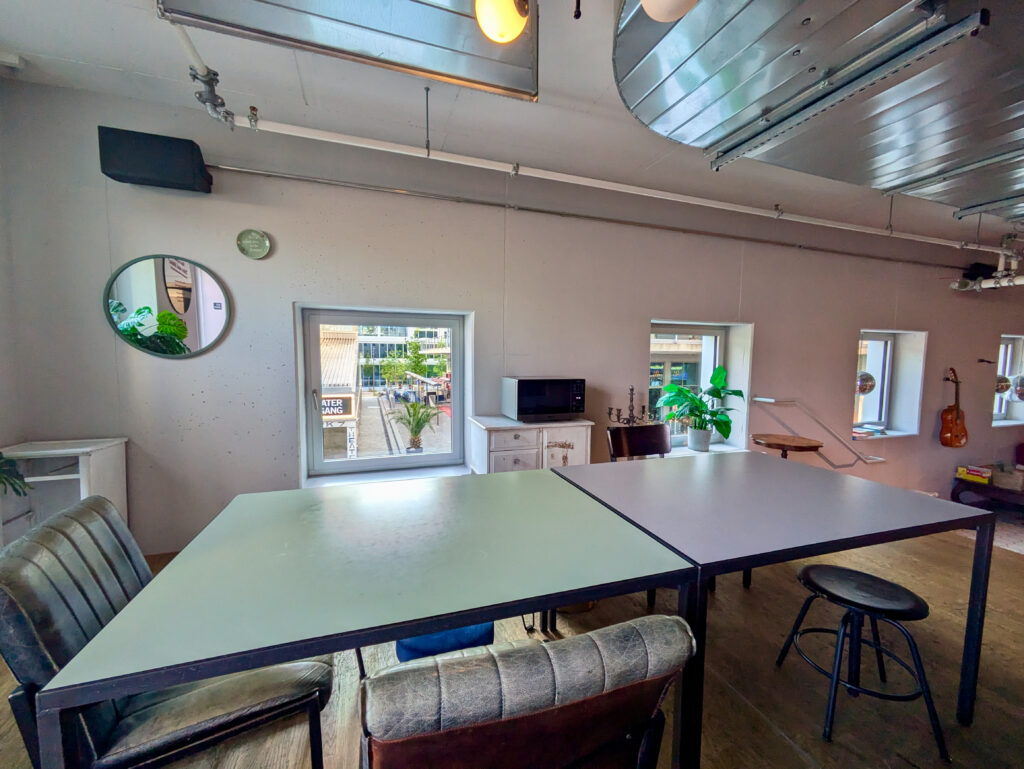
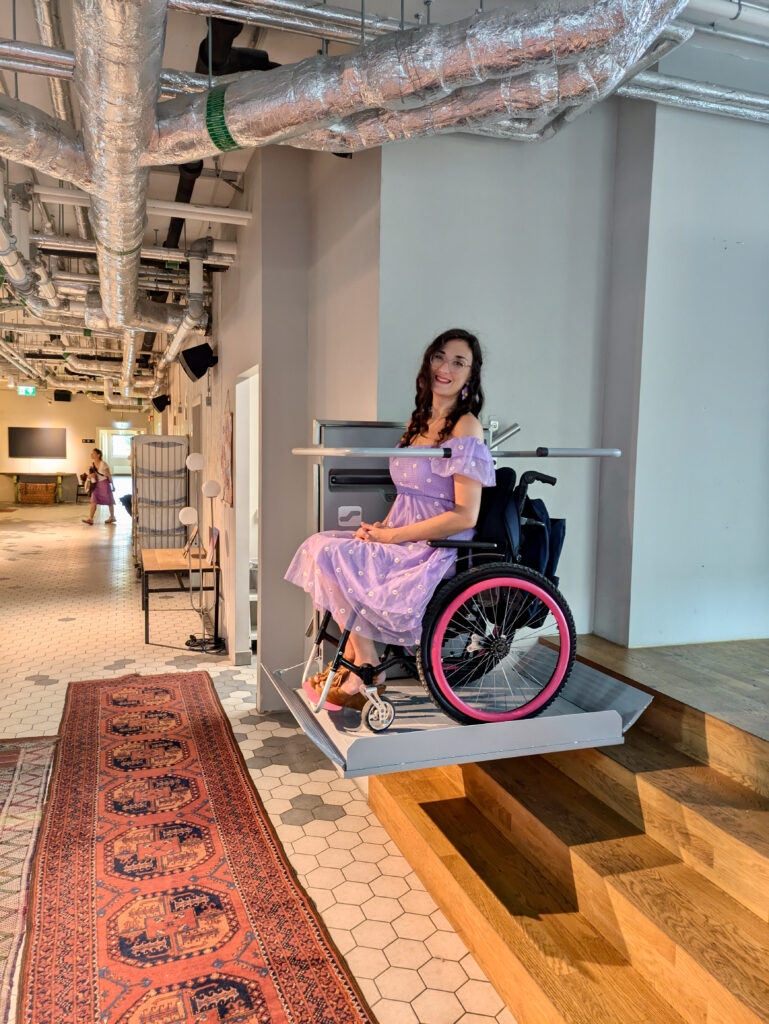
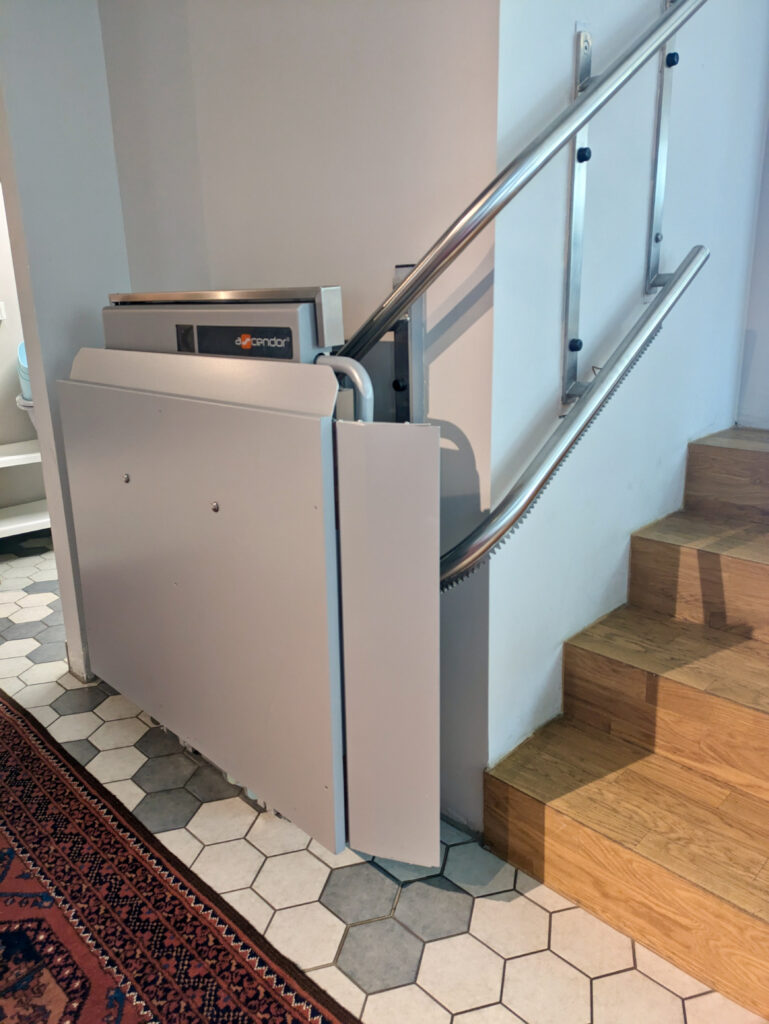
The kitchen area was just opposite this dining table area and I could easily wheel in and around here if it wasn’t busy. During our stay, this was really clean and tidy. There were lots of hobs you could use, even if another person was cooking whilst you were also in the kitchen. The fridge was filled with clearly labelled items to show which were free for anyone to use (often gifted by previous guests) and those that belonged to current guests within Wombat’s Hostel. The dates of expiry were also very helpful to ensure that every food item was as fresh as possible. There were also shared dry food items that previous guests had donated, including pasta and rice. Within a very short walk, there were plenty of low-cost supermarkets such as Lidl. We went there to get some really fun German sweets to give as gifts to our friends and family upon return. I love exploring supermarkets in different countries as you can find some really unique finds.
Of course, within the kitchen area there were certain items mounted on the wall such as communal saucepans, frying pans and plates that I couldn’t reach from my seated wheelchair position. If you were travelling with someone who could reach this then, of course, this is no concern. If not, the staff at reception were very helpful throughout my stay and I am certain they would just grab a pan or two off of the wall-mounted shelving units for you.
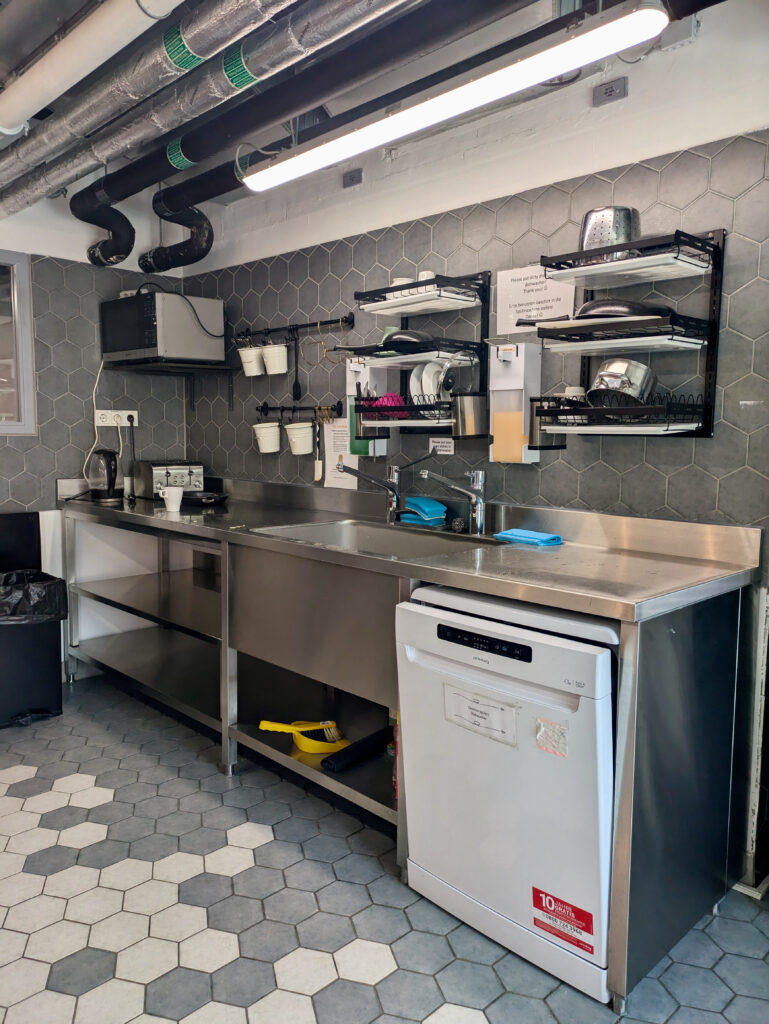


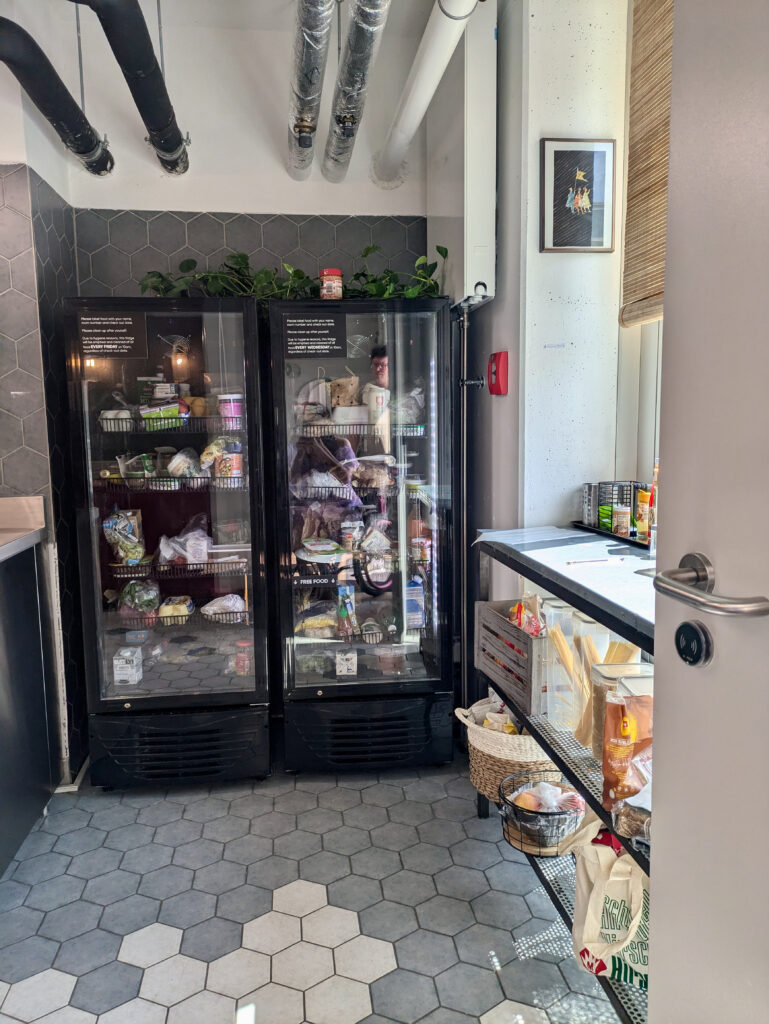
The outdoor balcony area we used was particularly lovely in the July sunshine. There were rustic crate tables and sofa units in this area. It was very popular with groups who were playing card games, drinking or generally socialising together. Plus, it has a wonderful view over Werksviertel and the bars, restaurants and clubs that surround the hostel. The area was vibrant, filled with life and there were plenty of things to do within a walkable/ wheelable distance of the hostel entrance. You could also see the ferris wheel from many parts of the hotel as it was right next door! We had a particularly good Asian meal one evening but there were so many wonderful places to dine and dance locally. Over the summer, we found that Werksviertel had a faux beach set-up and local live bands every single night. This was a great place to socialise, drink or just listen to the live music.
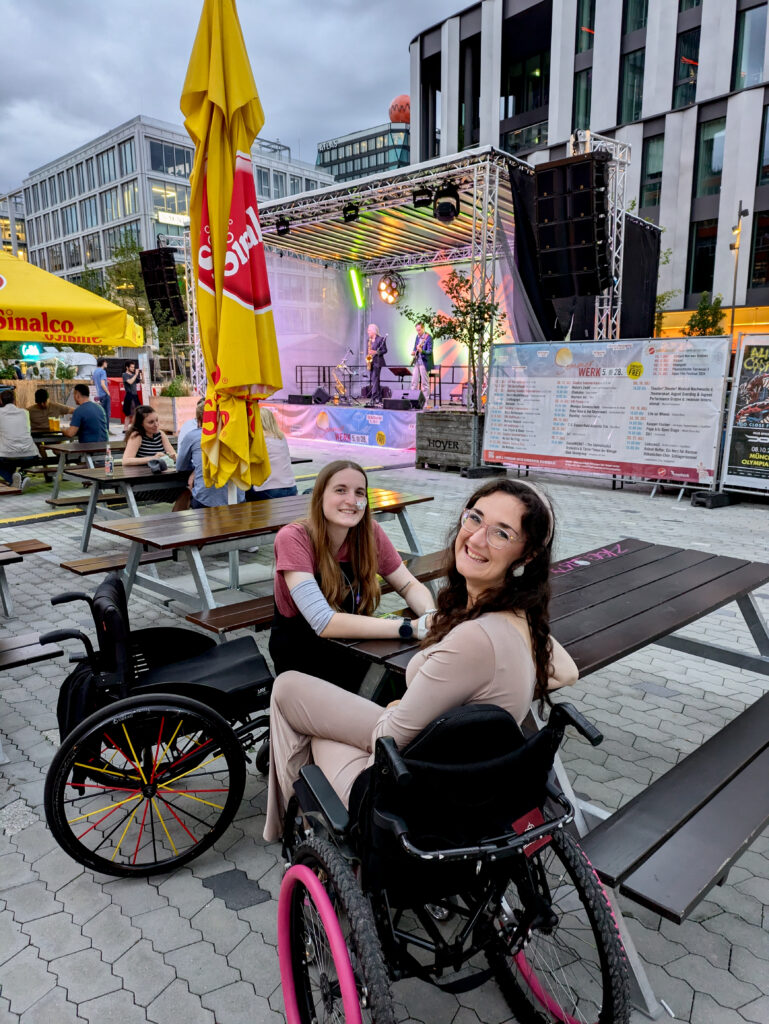
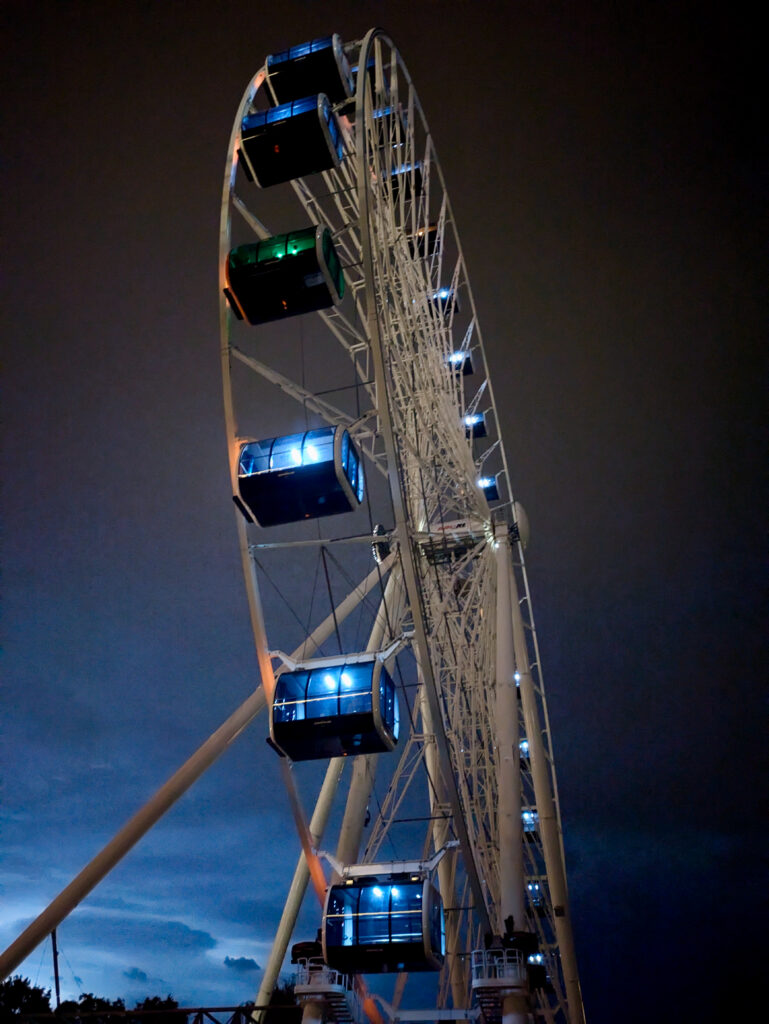
If you preferred to literally stay within the Wombat’s Hostel walls then there were plenty of fun events to attend during your stay. The scheduled rota at the WomBAR included Beer Pong every Tuesday, morning yoga and even a Taylor Swift afterparty which sounded very fun. Unfortunately we had returned to England by then – very sad. We did pop down to the bar on a couple of nights to play pool on their large table. The drinks were very reasonably priced and the bar was always full enough for it to feel fun and bustling. Every traveller we met there that was staying in Wombat’s Hostel Werksviertel were really nice and welcomed us over to have drinks occasionally. There was an accessible toilet right by the bar and I will showcase photos of that in my next post.

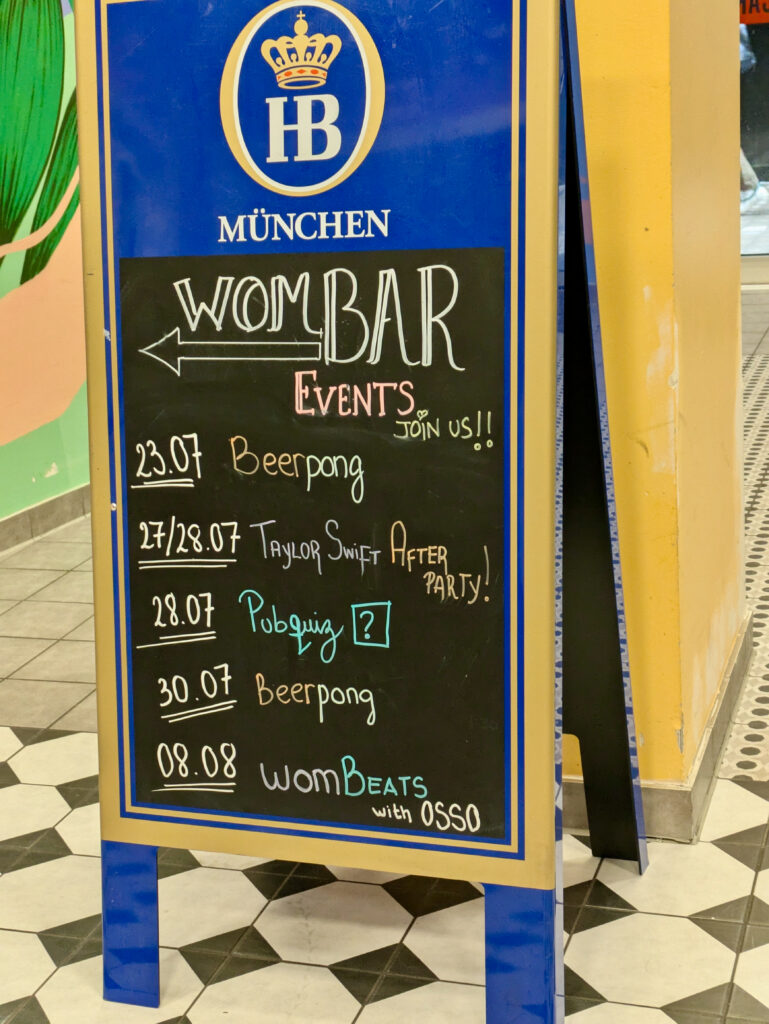
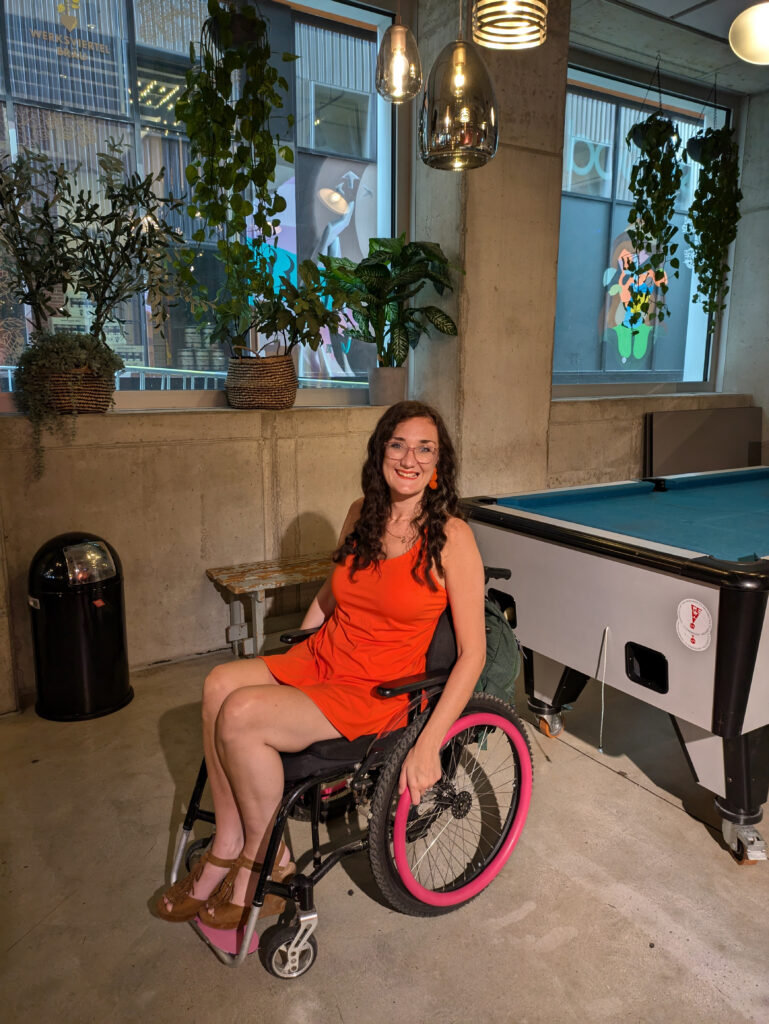
This WomBAR area is also where the buffet of continental breakfast was served in the mornings from 7am-10.30am. I will go into more detail about all the different offerings within this breakfast area in my next blog about Wombat’s Hostel. In my next post, I will also allow you to tour the different room sizes available. We stayed in the 6 person accessible dorm room but I was lucky enough to be able to view and photograph the double (or twin) room and a four person dorm room also. I will talk about these in greater detail within the next article but the photographs should allow you to assess whether these meet your access requirements.
Outside of Wombat’s Hostel, there is so much to see and do around Munich. Our whole holiday was jam-packed with activities such as museum tours, views of palaces, watching the surfers in the Englischer Garten (English Garden) in the central city and also visiting the site of historical importance at Dachau Concentration Camp Memorial. Within the next few articles, more of these sites and our wheelchair friendly activities in Munich will be explored in detail. I will also showcase how you would travel to these attractions and places using predominantly public transport from Wombat’s Hostel in Werksviertel, Munich.
We were travelling with two wheelchair users (Mary & Georgina) so all of our highlights from the trip were very accessible to many people. We particularly loved that it was so quick to get from anywhere in Munich and then back to Wombat’s Hostel for a rest or an evening in the cool and quirky restaurants that surrounded the hostel. We occasionally used the app “Bolt” which is a European form of Uber but did predominantly use public transport from Wombat’s Hostel. The nearest station is Munich Ost (East) and you can get directly onto both U-Bahn and S-Bahn underground and overground trains from there. Unfortunately the lift down to the train station at Munich Ost was broken during most of our stay but it was only a 15 minute accessible walk to the next nearest station. From this station of Ostbahnhof, you could also find various accessible buses and trams to explore the city.
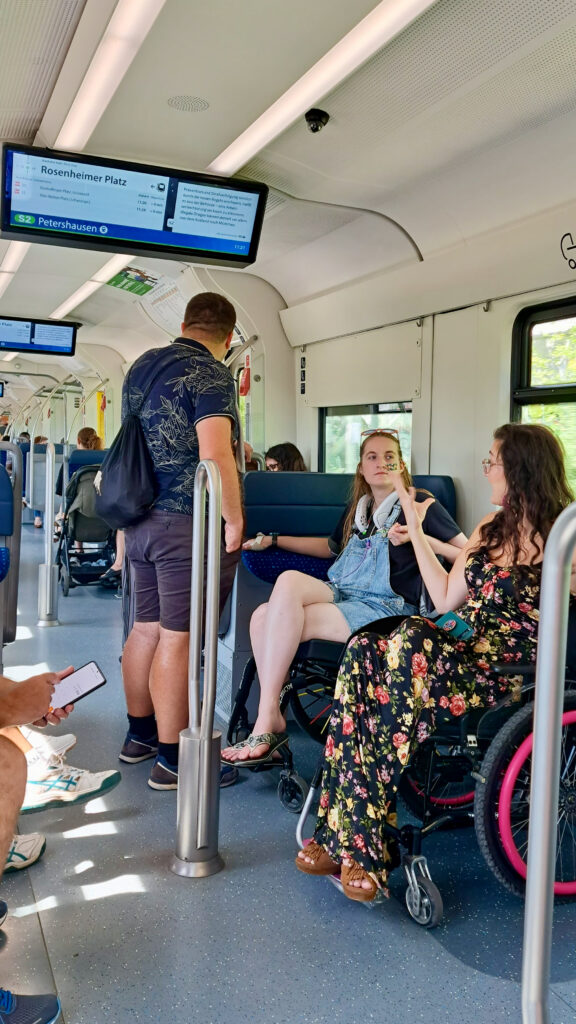
Munich has so much to offer you, whatever your interests are. I loved how friendly everyone was and how I could explore most of the city in a wheelchair accessible way. Of course, I am not finished with detailing the general wheelchair access and disability-friendly things we did in Munich so you can read about this, alongside a deeper exploration of the wheelchair accessible hostel of Munich’s Werksviertel Wombat’s Hostel, in the articles to come.
Thank you to Wombat’s Hostel for hosting us in the duration of our trip; we truly loved our stay and will absolutely return to stay within one of your Munich sites or even another city one day.
